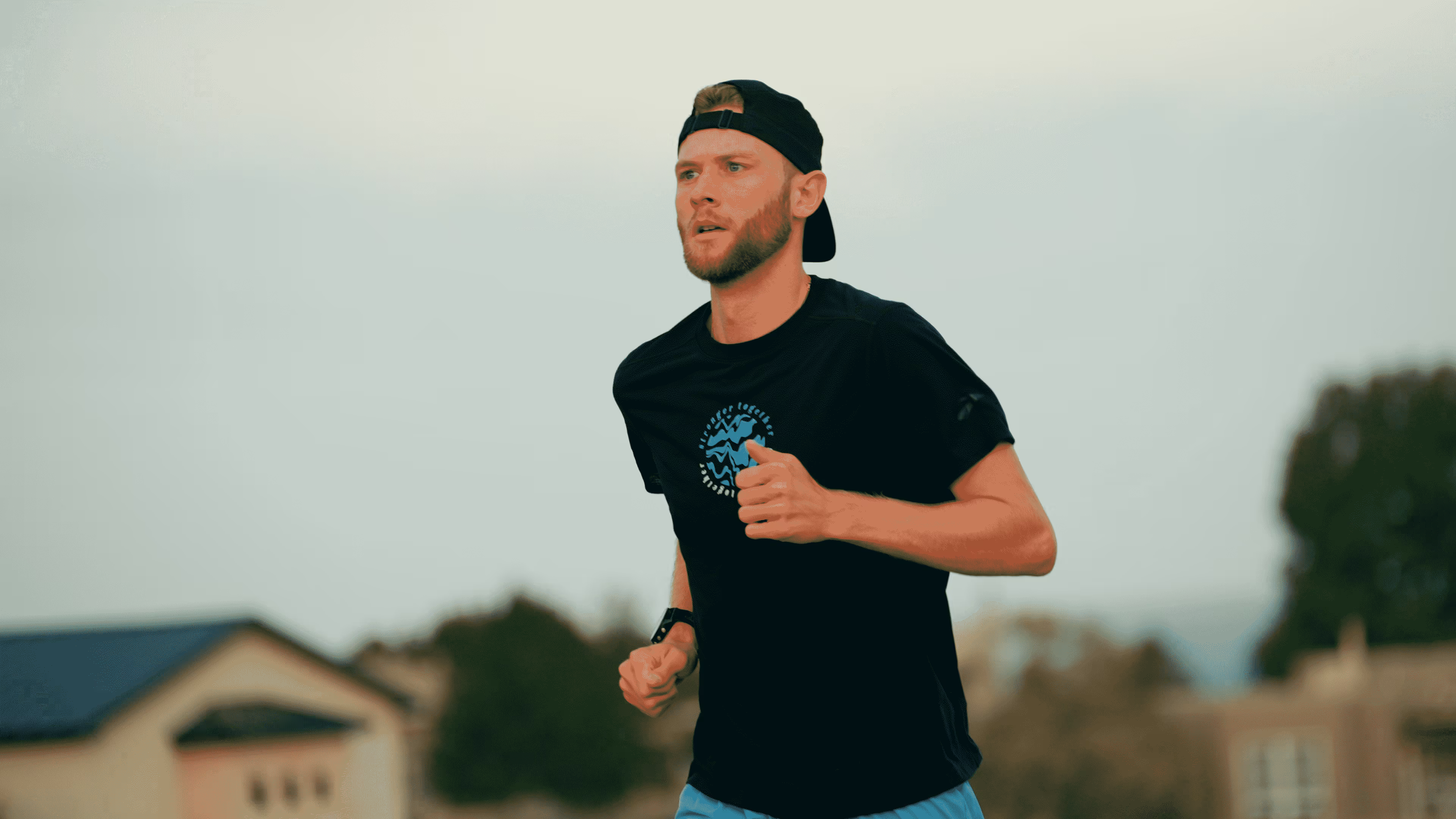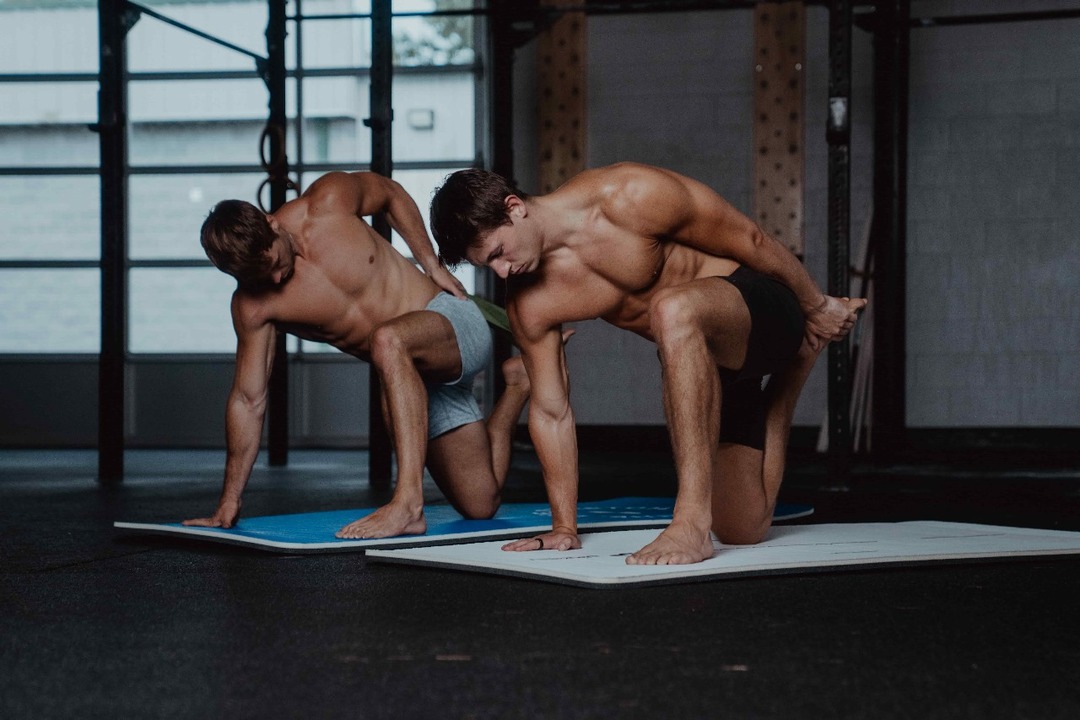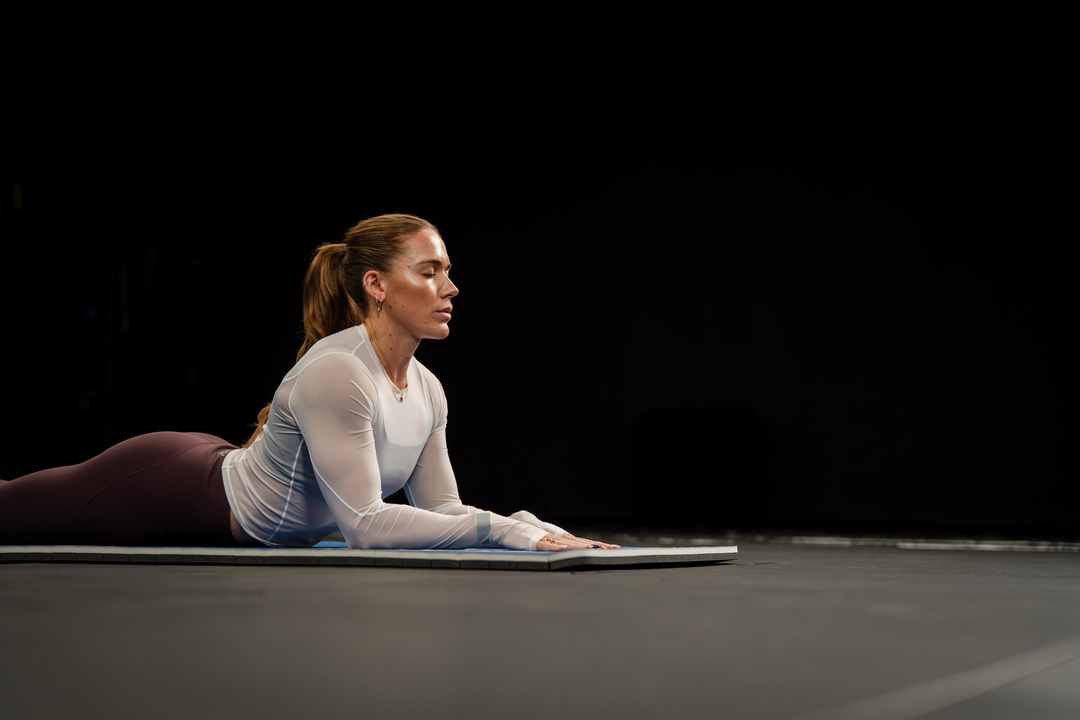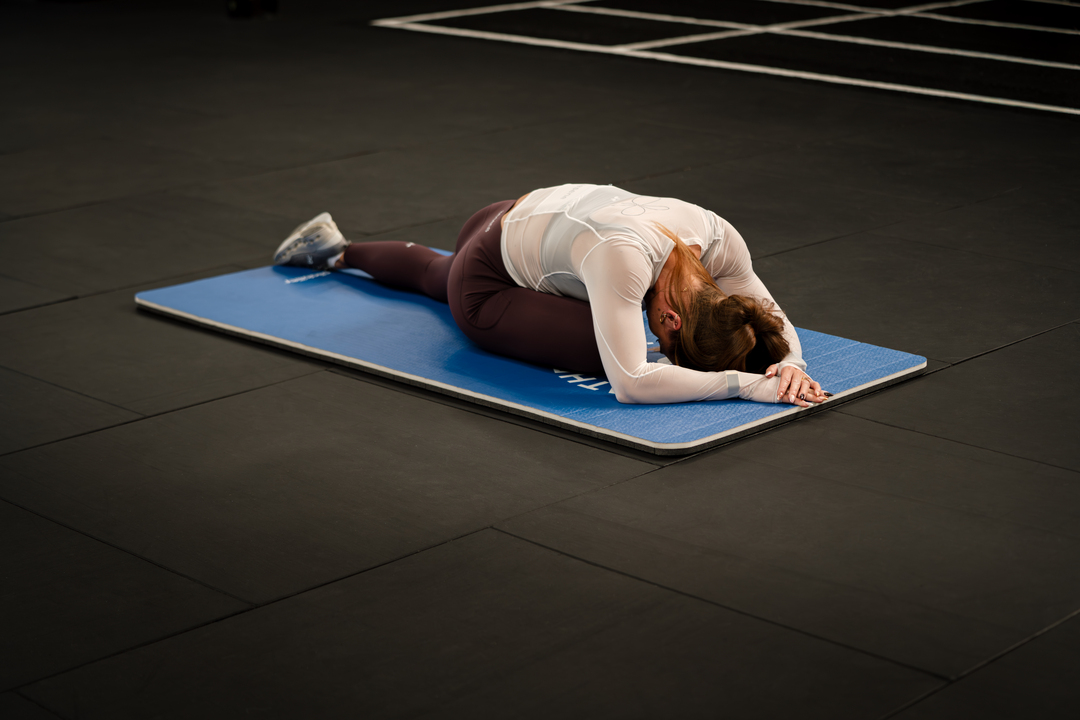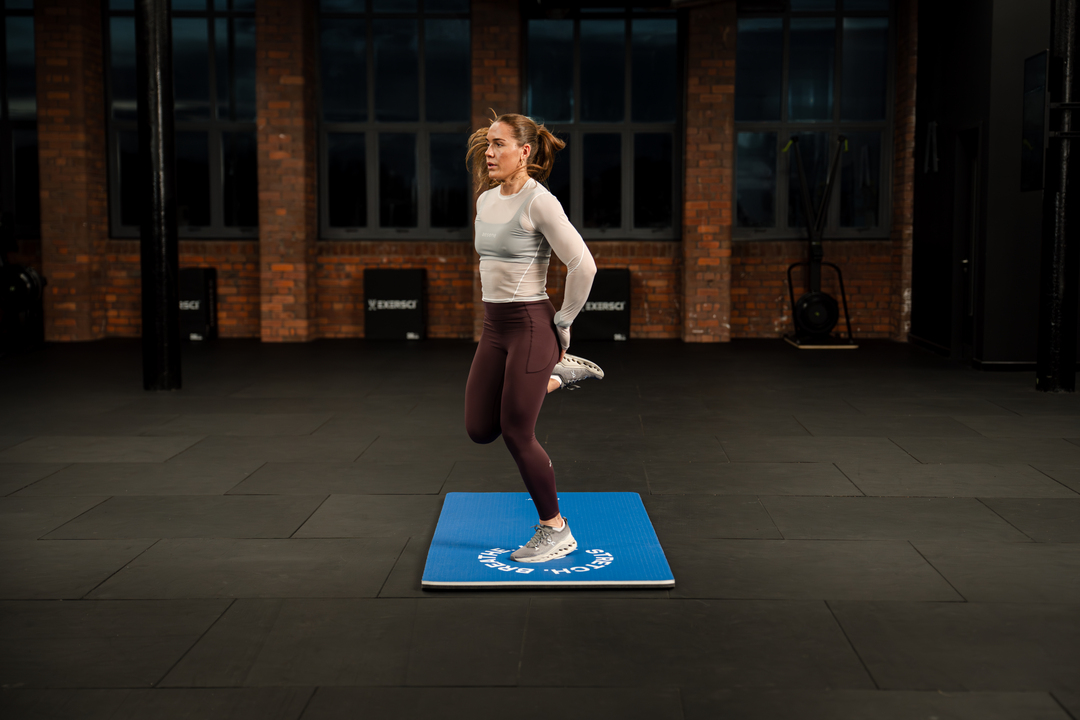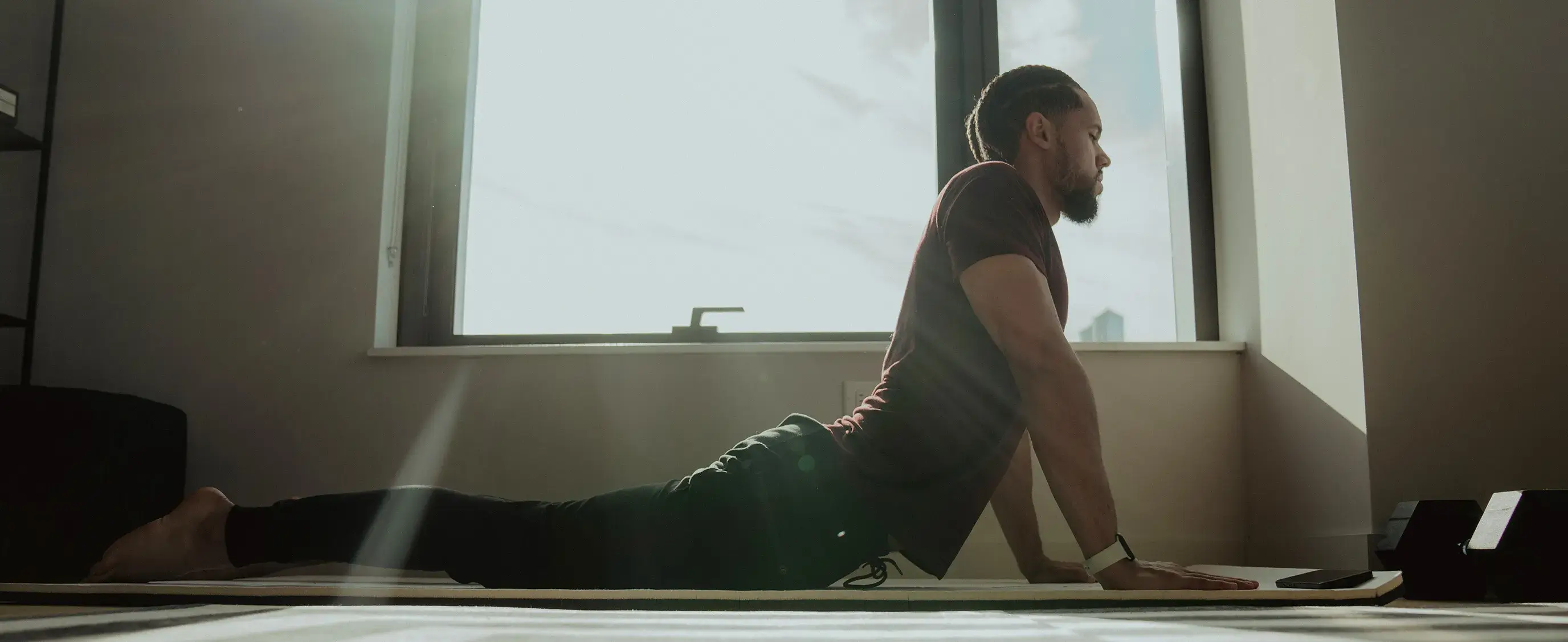You stretch before a workout, as you always have. You complete your warm-up, too. But a few minutes into your activity, you feel a twinge in your back. You ignore it. But by the end of your session, you can barely move. Poor mobility is very common among active individuals. It can limit performance and increase the risk of injury. Luckily, improving your mobility doesn’t have to be complicated. It can be as simple as adding regular mobility exercises to your routine.
This article will help you start by answering the question, what are mobility exercises? and outlining their benefits, regardless of your current fitness level. You'll also discover the best moves to enhance your flexibility and performance. Pliability’s mobility app can help you achieve your goals by offering an easy-to-use platform with customized routines and simple instructional videos.
What Is Mobility and Why Is It Important?

Mobility refers to the ability of joints and muscles to move freely through their full range of motion. It’s different from flexibility, which only refers to the range of motion of individual muscles or joints. While good flexibility can help improve mobility, it doesn’t guarantee it. You can be flexible but lack the strength and control to move well.
Good mobility means you can perform movements with ease, and that’s important for everyday functioning and reducing injury risk. Improving mobility can help enhance athletic performance, too.
“Having good mobility allows you to perform the movements and exercise that’s a part of your daily life—and it can make you less likely to suffer certain injuries,” Peloton instructor Andy Speer says. “Mobility basically gives your body room to move.”
Mobility Training: An Effective Way to Age-Proof Your Body
The excellent news about mobility is that it’s primarily a lifestyle choice. Regular physical activity is the key to increasing and maintaining good mobility. (That’s why children tend to have excellent mobility.) You don’t have to do cartwheels to boost yours; instead, try mobility training.
Mobility and Aging: Is There a Link?
Yes. While the adage, “if you don’t use it, you lose it,” most certainly applies to mobility, it’s not just sitting still for too long or skipping a workout or three that makes you less agile and accessible.
As you age, natural changes in the body can affect mobility, including:
- Muscle mass decline
- Reduced bone density
- Slower nervous system responses
These are just a few of the natural, age-related changes in the body that can affect how easily you move. On top of that, your mobility can be compromised by any of the oh-so-common chronic health conditions among Americans, such as:
- Arthritis
- Diabetes
- High blood pressure
- Cardiovascular disease
And your chances of being diagnosed with any of these increases as you age. It’s no wonder that pain, stiffness, and reduced range of motion occur more frequently with age. But you don’t have to succumb to these difficulties. You can lessen their impact with mobility training.
Related Reading
- Ankle Mobility Exercises
- Shoulder Mobility Exercises
- Hip Mobility Exercises
- How To Improve Flexibility
- Thoracic Mobility Exercises
- Stretch Before Or After Workout
- Wrist Mobility Exercises
- Mobility Exercises For Beginners
- Best Stretching Routine
- Back Mobility Exercises
- Lower Body Mobility Exercises
- Leg Mobility Exercises
- Mobility Exercises For Athletes
What Are Mobility Exercises?
.jpeg)
Mobility training involves exercises and movements that strengthen and lengthen your body, allowing you to move freely and efficiently. A mobility training class may include elements of a variety of fitness routines you may or may not already be familiar with, such as:
- Dynamic stretches
- Foam rolling
- Bodyweight exercises
- Yoga
- Pilates
The Difference Between Flexibility and Mobility

To understand why mobility training is so beneficial, look at how it compares with flexibility, another useful physical characteristic to hone for your overall health. Flexibility is how much a muscle, ligament, and tendon can stretch. Mobility, on the other hand, is a combination of:
- Flexibility
- Coordination
- Stability across various ranges of motion in multiple joints and muscle groups.
“It's the ability for a joint to move well through its full range of motion,” explains Sanchez. Think of it this way: Flexibility is whether you can touch your toes standing with straight legs. Mobility is how easy it is to bend at your hips and knees to touch your toes—the movement is the key. To be clear, you need both.
“It’s important to have both work together because mobility goes beyond flexibility by emphasizing movement capacity and control at various ranges of motion in multiple planes,” explains Sanchez.
Mobility training exercises are about much more than just being flexible. Done right, and regularly, mobility training can:
- Increase your range of motion
- Relieve tight muscles
- Ensure good posture and proper athletic form
- Prevent injury
“Mobility classes are versatile and effective,” Andy says. “You can use them to start your day, end your day, as an active recovery on non training days, or as a low-intensity exercise when you want to move a little but not engage in a full workout. It’s a fun way to explore how well your body’s moving.”
Mobility training is ideal for men and women of all ages and fitness levels. It’s especially perfect for workout newbies or those who’ve tried but have been unsuccessful at exercising regularly. Once mobility improves, energy, drive, and ability to work out harder in other areas increase.
Mobility training can improve athletic performance for athletes and regularly active adults and help ward off the dreaded but widespread overuse injuries.
Mobility Training vs. Stretching vs. Foam Rolling
Although mobility training sounds like stretching or foam rolling, the focus and goal of each activity differ significantly.
Stretching
Stretching mostly focuses on lengthening muscle and other soft tissue to increase flexibility, typically in a few common problem areas of the body:
- The calves
- Thighs
- Low back
- Hips
- Neck
- Shoulders
Static stretching—extending a muscle and holding it there for 10-30 seconds, like a toe touch—can help you recover after a workout or injury. On the other hand, dynamic stretching, or controlled movements that mimic your activity or sport (think lunges or arm circles), is best done as a warm-up before a workout or intense activity.
Foam Rolling
Foam rolling is used to relieve muscle tension. Using a rigid foam cylinder, you use your body weight to press on specific points in your body by rolling the area back and forth over the cylinder.
Mobility Training
Mobility training utilizes techniques that address the following:
- Muscles
- Tendons
- Ligaments
- Joints and its range of motion
It also involves:
- High degree of control
- Coordination
- Awareness
- Effectively looping in your nervous system
Mobility training focuses on how you function and move as an entire body rather than individual muscle groups. It also targets movement patterns fundamental to daily life and specific types of athletic performance. You might consider mobility training the best of all possible worlds: It takes a more comprehensive and holistic approach than simply stretching or foam rolling.
Equipment for Mobility Training
Most often, mobility training requires little, if any, equipment. At Peloton, our instructors might use:
- Yoga blocks
- Foam rollers
- Resistance bands
Among other items:
- Mat: Provides a comfortable surface for exercises performed while sitting or lying down.
- Yoga Blocks: Used to support your body in various poses.
- Foam Rollers: Used to help relax and stretch muscles.
- Resistance Bands: To assist with reaching parts of the body that may be difficult to reach without assistance.
- Massage Ball: Used to target and relieve strain in hard-to-get-to muscle groups.
“The cool thing about mobility training is that you can usually do them anywhere—with minimal or no equipment,” Andy says.
Improve Your Performance with Pliability's Tailored Yoga App

Pliability offers a fresh take on yoga tailored for performance-oriented individuals and athletes. Our app features a vast library of high-quality videos designed to:
- Improve flexibility
- Aid recovery
- Reduce pain
- Enhance range of motion
Pliability provides daily-updated custom mobility programs for those interested in optimizing their health and fitness. It also includes a unique body-scanning feature to pinpoint mobility issues. If you're feeling limited by pain or the ability to move, Pliability aims to complement your fitness routine and help you move better.
Sign up today for 7 days absolutely free on iPhone, iPad, Android, or our website to improve flexibility, aid recovery, reduce pain, and enhance range of motion with our mobility app.
9 Benefits of Regular Mobility Training
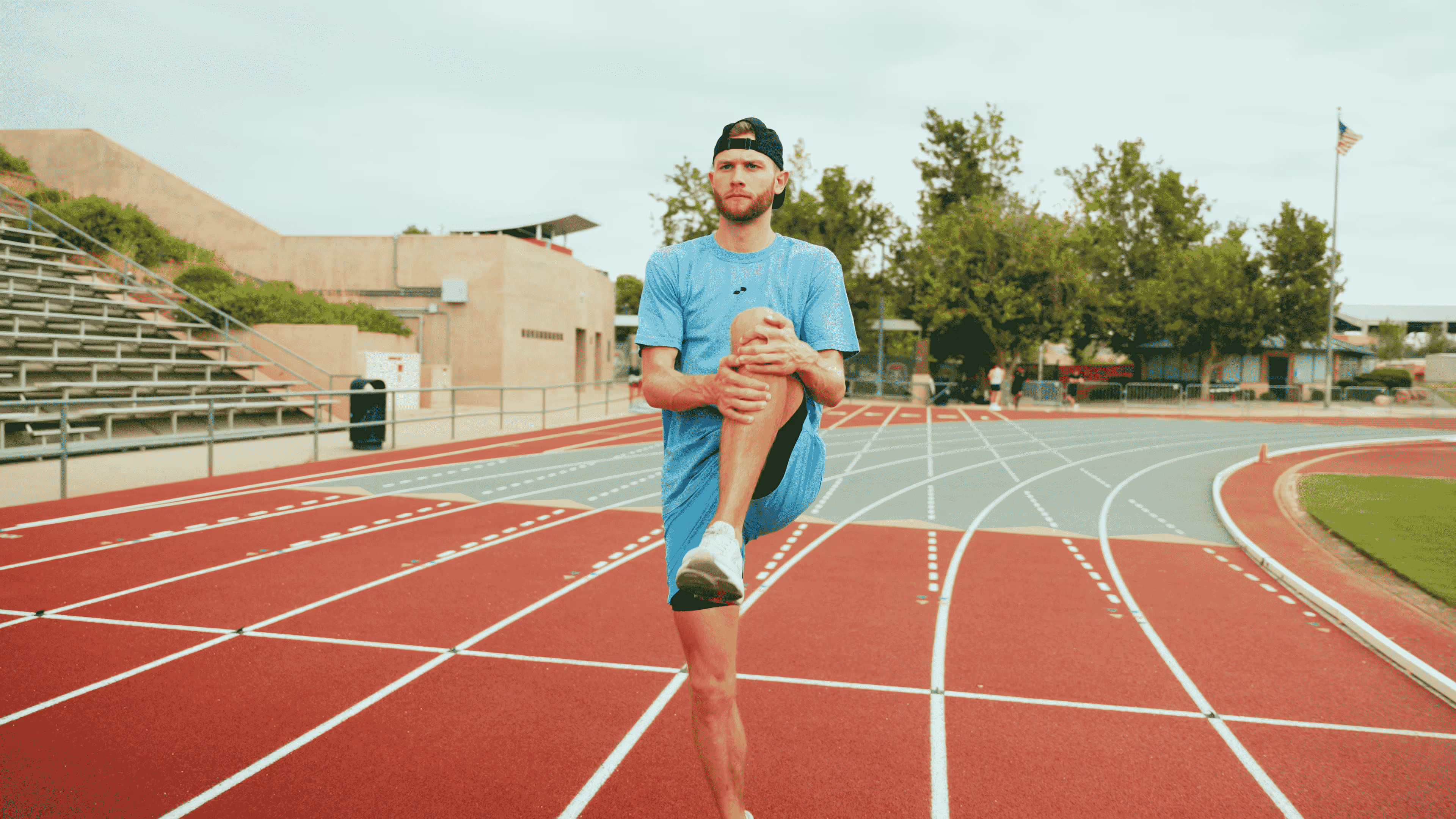
1. Greater Proprioception
Proprioception is awareness of your body in space. Honing your senses in this way can improve your form and technique, potentially increasing your results.
2. Builds Strength
While the results may not be as dramatic as those of a high-intensity cardio workout, mobility exercises are incredible in their own right. You may notice some soreness the day after, but that's a sign that you've engaged muscles often underused during more conventional gym workouts.
3. Boosts Mental Mojo
Mobility exercises are typically performed with a slow and intentional rhythm, often in harmony with your breath. This deliberate approach can:
- Promote mindfulness
- Reduce stress
- Enhance mental well-being
It's a practice that allows you to be present in the moment and tune into your body's needs.
4. Improved Daily Activity
As the saying goes, "Use it or lose it." Regular mobility exercises are an excellent way to maintain your body's functionality as you age. A small commitment of time each week can significantly impact your overall well-being, ensuring you enjoy an active and fulfilling life.
5. Increased Flexibility
Do you think you need to be more flexible? Think again! Mobility exercises target specific muscle groups and joints, leading to improved flexibility. Over time, the range of motion expands, making everyday activities more comfortable and efficient.
6. Injury Prevention
As we age, our bodies become more susceptible to injury. Mobility exercises work against this by strengthening the muscles, ligaments, and tendons surrounding your joints, reducing the risk of injuries and providing stability.
7. Enhanced Posture
Mobility exercises often focus on the muscles that support good posture. Mobility exercises can help prevent poor posture and related problems by reducing strain around the spine.
8. Pain Management
Mobility exercises can be valuable for managing chronic pain and discomfort. For chronic conditions like arthritis or muscle stiffness, mobility exercises can be a practical addition to a pain management routine.
9. Variety
One of the most appealing aspects of mobility exercises is their endless variety. Explore various movements and techniques, ensuring your routine remains fresh and engaging. Integrating mobility exercises into your movement routines is a game-changer. Inclusive and adaptable, mobility exercises are accessible to everyone, regardless of age or previous experience.
How to Start Mobility Training

Mobility training isn’t a specific type of workout. Instead, think of it as a general athletic skill, like strength or power or speed, says Joe Holder, a performance specialist at S10 gym in New York, Nike trainer/run coach, and founder of The Ocho System.
And as with building strength or speed, you must build mobility with multiple techniques. At the bare minimum, Holder suggests a warmup routine with three components:
- Myofascial work includes foam rolling or ball rolling.
- Controlled dynamic stretches
- Bodyweight movements, like the squat or lunge.
The Benefits of Controlled Dynamic Stretching
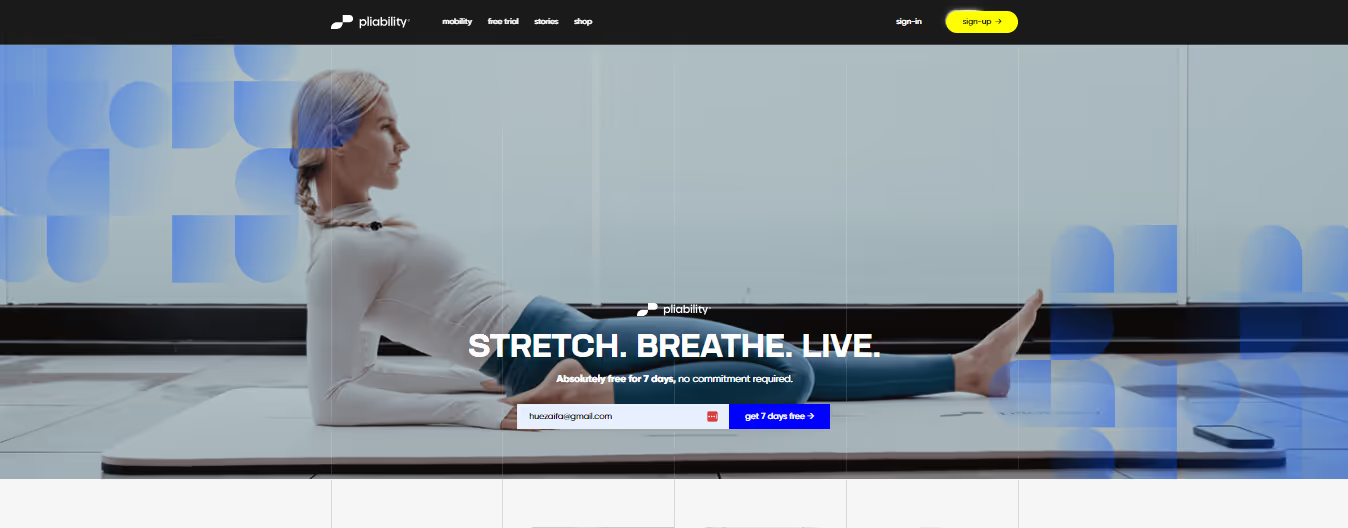
Most importantly, move slowly and deliberately. According to a 2017 study published in Sports Medicine, controlled dynamic stretching will increase joint range of motion and enhance muscle power better than static stretching (stretch and hold) and ballistic stretching (stretch and bounce).
Base your warmup on your workout. Before lower-body workouts, do:
- Hip circles
- Legs swings
Buddha squat holds to open up the musculature around your:
- Hips
- Quads
- Hamstrings
- Calves
- Ankles
“Before upper-body workouts, do scarecrows and shoulder circles to increase range of motion in the shoulders (specifically the rotator cuff). Matching your warmup with your workout will activate the muscles you're focusing on and cement proper joint alignment and muscle activation in your brain”, Holder adds.
In addition to pre-workout mobility, incorporate functional movements into your daily workouts. Trade your typical cardio for swimming or rowing to improve your upper-body range of motion. Work moves like bear crawls or duck walks into your strength sessions. Turn an active recovery day into a low-intensity mobility day for serious range-of-motion gains. Holder suggests taking a yoga class or doing one warmup routine focusing on trouble areas, like tight shoulders or hamstrings.
17 Best Mobility Exercises to Boost All Kinds of Workouts

1. Spider Lunge
The spider lunge is a dynamic stretch that enhances hip mobility and prepares the body for various movements, especially those involving rotation.
How to Do It
- Start in a plank position.
- Step your right foot outside your right hand.
- Push your hips forward and squeeze the glute of the left leg.
- Return the front foot to the starting position.
- Repeat on the opposite side.
Benefits
This exercise loosens tight hip flexors and warms the groin, glutes, and lower back.
2. Crescent Lunge
The crescent lunge is another effective way to improve hip mobility.
How to Do It
- Kneel on the ground and place one foot in front of you in a lunge position.
- Push your hips forward and squeeze the glute of the back leg.
- For an extra stretch, raise the arm on the same side of the back leg and lean inward to deepen the hip stretch.
- Hold for a few seconds
- Repeat on the other side
Benefits
This movement targets the hip flexors, groin, and glutes.
3. World’s Greatest Stretch
The world’s greatest stretch is a great way to improve overall mobility.
How to Do It
- Start in a plank position.
- Step your right foot outside your hand.
- Squeeze the left glute and then drop your right elbow toward the ground, feeling the stretch on the back of the thigh.
- Twist back through center and continue to rotate your torso to bring your right arm straight up to the ceiling, following your hand with your eyes.
- Return the palm to the plank position.
- Repeat on the opposite side.
Benefits
This exercise opens up the hips while stretching the hamstrings, groin, and thoracic spine.
4. Posterior Capsule Stretch
This stretch targets the outside of the hip to improve mobility.
How to Do It
- Begin on your hands and knees, knees under hips, and palms under shoulders.
- Cross one foot over the other.
- Lean to the side so you feel the stretch outside your hip.
- Return to the starting position.
- Repeat on the opposite side.
Benefits
The posterior capsule stretch is especially effective for loosening up the hips before activities like running that can be hard on the joints.
5. Adductor Rocks/Inner Thigh Groin Stretch
This mobility exercise targets the inner thigh and groin.
How to Do It
- Start on all fours with knees in line with hips and palms in line with shoulders.
- Extend one leg to the side with your foot flat on the ground.
- Rock your hips backward so you feel the stretch on the inside of your thigh and inner groin.
- Return knee to starting position.
- Repeat on the opposite side.
Benefits
This exercise helps improve mobility in the inner thigh and groin, which can help with better hip function.
6. Cossack Squat
The cossack squat helps improve mobility in the hips and lower body while also building strength.
How to Do It
- Stand with feet wider than shoulder-width apart, toes turned slightly out, and arms straight out in front of your chest.
- Shift your weight onto your right side as you sit back into your hips, bending your right knee into a squat.
- Lower until your right thigh is parallel to the floor (or deeper), keeping the left leg fully extended to the side with the heel planted.
- Pivot the toes of your left foot upward while keeping your chest lifted and your right heel flat on the floor.
- Press through your right foot to return to standing.
- Repeat on the opposite side.
Benefits
This movement targets the hips, groin, and quadriceps.
7. 90-90 Stretch
The 90-90 stretch is a great exercise for improving hip mobility and flexibility in the glutes.
How to Do It
- Begin sitting with one leg bent in front of your body at a 90-degree angle with your shin parallel front.
- Bend your back leg into the same 90-degree angle behind you so your knee is in line with your hip.
- Pivot so to reverse the shape, lifting knees and dropping them to the other side.
- Brace your core and push through the floor to lift hips, squeezing glutes at the top.
- Slowly sit back down, maintaining a 90-90 shape with both legs.
- Pivot to repeat on the opposite side, lifting hips at the end.
Benefits
The 90-90 stretch targets the hips and glutes, promoting better mobility for rotation.
8. Lumbar Rotation/Lumbar Windshield
This exercise helps improve mobility in the lower back.
How to Do It
- Lie on your back with knees bent together, feet flat on the floor.
- Slowly twist the lower spine so knees drop to one side.
- Stop when shoulders begin to lift from the ground.
- Pause, then return to the center.
- Repeat on the opposite side.
- Continue switching sides.
Benefits
This exercise relieves tension in the lower back and helps improve rotational mobility.
9. Prone Lumbar Twist/Scorpion
The prone lumbar twist, or scorpion stretch, also targets the lower back.
How to Do It
- Lie face down on the ground face down with your forehand resting on the backs of hands for support.
- Keeping your torso connected to the floor, lift your right leg, crossing it up and over the left until your right foot taps the ground.
- Pause briefly, then return to the starting position.
- Repeat on the opposite side.
- Continue switching sides.
Benefits
This movement helps relieve tension in the lower back and improves mobility.
10. Squat with Thoracic Twist
This exercise targets the hips and thoracic spine, promoting better mobility for squats and other movements.
How to Do It
- Stand with your feet hip-width apart.
- Bend your knees to lower down into a squat.
- At the bottom of the movement, open your arms out wide, twisting your torso to the right as you lift your right arm straight up, following your hand with your eyes.
- Return to the center and twist to the left side, raising your left arm toward the ceiling.
- Repeat alternating sides.
Benefits
The squat with thoracic twist improves hip, core, and upper back mobility.
11. Shoulder CARs
Shoulder CARs are controlled movements that help improve mobility in the shoulder joint.
How to Do It
- Stand up tall in a balanced stance.
- Raise one arm straight up with your palm facing inward.
- As you reach the top point (with your arm extended straight up), turn your palm away from yourself as much as mobility allows.
- Continue moving your arm through the range of motion until you reach the starting position.
- Perform 10 controlled repetitions, then switch arms.
Benefits
This exercise helps promote healthy function in the shoulder joint and improves range of motion.
12. Thoracic Extension on Foam Roller
This exercise improves mobility in the thoracic spine, which can help reduce strain on the lower back.
How to Do It
- Put the foam roller on the floor.
- Lie down and press your mid-back into the roller so it’s perpendicular to your body.
- Raise your arms and clasp your hands behind your head, tucking in your elbows.
- Using the foam roller as a hinge, extend your back as far as your mobility allows.
- Hold the position for 3 seconds, then return to the starting position.
- Repeat for a total of 10 repetitions.
Benefits
The thoracic extension on a foam roller targets the upper back to improve mobility and function.
13. End Range Lift-Offs
End range lift-offs target the shoulder and promote better mobility for overhead movements.
How to Do It
- Lie face down on the floor, with your chest on the ground and your neck in a neutral position (not looking up).
- Extend your arms above your head in a ‘Y’ position, with your hands resting on the floor.
- Raise your arms straight up on the floor while keeping them straight.
- Hold the position for three seconds, then slowly lower your arms back down.
- Repeat for a total of 10 repetitions.
Benefits
This exercise helps improve strength and control in the shoulder at end ranges of motion.
14. Horizontal Ts
Horizontal Ts improve strength in the upper back and shoulders to promote better mobility for the shoulders.
How to Do It
- Lie on the floor on your stomach with your arms extended out to the sides in a T position.
- Position your hands in a ‘thumbs up’ orientation.
- Squeeze your shoulder blades together and lift your hands off the floor.
- Hold for 3 seconds, then lower back down to the starting position.
- Repeat for 10 repetitions.
Benefits
This exercise targets the upper back and shoulders to improve mobility and function in the shoulder joint.
15. ER (External Rotation) Lift-Offs
External rotation lift-offs target the rotator cuff muscles to improve shoulder stability and mobility.
How to Do It
- Lie face down on the floor with your arms extended out to your sides in a goalpost position.
- Place a yoga block underneath one elbow.
- Rotate that arm up to raise it off the block.
- Hold this position for 3 seconds.
- Repeat for 10 reps, then switch the block to the other arm for 10 reps.
Benefits
This exercise targets the shoulder's external rotators to improve joint mobility and stability.
16. Hitchhiker
The hitchhiker exercise targets mobility in the thoracic spine and helps improve shoulder function.
How to Do It
- Begin on the floor with your hands and knees in a tabletop position, wrists below shoulders and knees below hips.
- Form your right hand into a fist, with your thumb pointing up in the “hitchhiker” position.
- Lift your right arm in front of you to shoulder height.
- Lower your arm back to the starting position.
- Repeat 8 to 12 times, switch sides, and repeat with your left arm.
Benefits
This exercise helps improve mobility in the thoracic spine and shoulder for better overall function.
17. Hamstring and Hip Opener
The hamstring and hip opener stretch helps improve mobility in the hips and targets the hamstrings.
How to Do It
- Kneel on the floor with your knees about hip-width apart.
- Step right foot forward so right knee is over right ankle and right thigh is parallel with the floor.
- With arms to sides or hands on hips, shift weight back as you lean from hips over right foot allowing right toes to come up. (If you need some balance, place your hands on the floor.)
- Release to start and repeat 8 to 12 times
- Switch sides and repeat.
Benefits
This exercise improves mobility in the hips and hamstrings and can help with better performance and reduce risk of injury.
Related Reading
- Golf Mobility Exercises
- Upper Body Mobility Exercises
- Mobility Exercises For Runners
- Can You Over Stretch
- Squat Mobility Exercises
- Functional Mobility Exercises
- Why Stretching Is Important
- Foot Mobility Exercises
- Arm Mobility Exercises
- Hamstring Mobility Exercises
- Elbow Mobility Exercises
- Rotator Cuff Mobility Exercises
- Bed Mobility Exercises
- Full Body Mobility Exercises
How Much Mobility Work Do You Need

The frequency and duration of mobility training vary depending on fitness level, goals, and health status. Beginners might start with a few weekly sessions before gradually increasing duration and frequency. Everyone should strive for some mobility training every day.
Mobility Training Recommendations for Beginners
Beginners should aim for 2-3 mobility sessions each week. As you feel more comfortable with mobility training, gradually increase the frequency to five days a week while adding duration. Start with shorter sessions of 5-10 minutes and work up to 15-30 minutes. Beginners should also focus on only a few exercises, concentrating on proper form before progressing to more advanced movements.
Mobility Training Recommendations for Intermediate and Advanced Fitness Levels
If you’re more experienced with fitness and have a solid mobility base, aim for at least 5-6 weekly mobility sessions. These sessions should range from 10-30 minutes, depending on how well you can maintain mobility and if you’re working to improve any specific problem areas. You should also integrate mobility training into your regular workouts to help with recovery, warm-ups, or cool-downs.
Related Reading
- Gowod Vs Pliability
- Tennis Mobility Exercises
- Weighted Mobility Exercises
- Cervical Mobility Exercises
- Resistance Band Mobility Exercises
- Rib Mobility Exercises
- Glute Mobility Exercises
- Best Yoga App
- Free Apps For Stretching And Flexibility
- Mobility Apps
- Stretching Apps
- Chest Mobility Exercises
- Glute Stretches
- Gluteus Medius Stretch
- Glute Stretch
- Cervical Radiculopathy Exercises
How to Safely Add Mobility Training to Your Workout Routine

Mobility work helps reduce injuries and improve performance. "Mobility improves your body's ability to move efficiently and effectively," says physical therapist and human performance specialist Kelsey Sanchez, DPT.
"This translates to better workouts, as you’ll be more coordinated, stable, and strong, which helps you to lift heavier and perform better on the field or court."
For example, a person with better hip mobility may be able to perform a more effective squat with less chance of injury. This will help their workouts, as they will be able to perform the movement better, and with less chance of injury, they’ll be able to progress their training and improve their performance. If you want to improve your squat, adding mobility drills to your routine that target the hips will help.
Improve Your Flexibility with Our Mobility App Today | Get 7 Days for Free on Any Platform

Mobility exercises target the active range of motion of joints. They help maintain and improve joint health and reduce discomfort and pain associated with stiff or injured joints. Mobility drills are often confused with flexibility exercises; while they are related, they are different.
Flexibility vs. Mobility
Flexibility is passive. It refers to the ability of muscles and other tissues to lengthen and accommodate a stretch. Mobility is active and refers to a joint's degree of controlled motion. Improving your mobility can:
- Enhance athletic performance
- Eeduce injury risk
- Make everyday activities easier.
